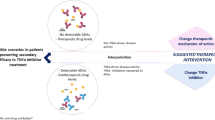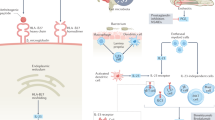Abstract
The course of axial spondyloarthritis (axSpA), including ankylosing spondylitis (AS), is strongly influenced by the degree of disease activity over time, which is mainly based on inflammation, and by the impairment of function, which is based on structural damage—mainly, new bone formation—and inflammation. In AS, nonsteroidal anti-inflammatory agents are currently recommended as the first choice of medical therapy, and there is also a clear role for regular exercise and physiotherapy in order to preserve and prevent loss of spinal mobility. For patients who have insufficiently responded to conventional medications, there are now four biologics approved for the treatment of patients with active AS in many countries, all directed against TNFα: infliximab, etanercept, adalimumab, and golimumab; studies with certolizumab are currently ongoing. Several studies with patients classified as nonradiographic axSpA have also shown a good response to TNF blockers; in patients with early disease and high CRP levels, the response rates were even better. Long-term studies with TNF blockers have shown declining retention rates over time but sustained clinical efficacy in the patients who remained on treatment. States of drug-free remission are rarely reached and only for relatively short periods of time. More studies including magnetic resonance imaging (MRI) are needed to further examine the lack of effect of anti-TNF treatment on radiographic progression in the axial skeleton. Whether the effect of an early intervention with biologics will prevent the development of bone growth in patients with nonradiographic axial SpA remains to be seen. Biologics other than TNF blockers are currently not recommended for the treatment of patients with axSpA, because of insufficient evidence of clinically relevant efficacy. The anti-IL-17a antibody secukinumab may be efficacious, on the basis of a proof-of-concept trial. Finally, first data on biosimilars of TNF blockers have recently been presented.
Similar content being viewed by others
References
Wellcome Trust Case Control, C, et al. Association scan of 14,500 nonsynonymous SNPs in four diseases identifies autoimmunity variants. Nat Genet. 2007;39(11):1329–37.
Braun J, et al. Prevalence of spondylarthropathies in HLA-B27 positive and negative blood donors. Arthritis Rheum. 1998;41(1):58–67.
Saraux A, et al. Prevalence of rheumatoid arthritis and spondyloarthropathy in Brittany, France. Societe de Rhumatologie de l'Ouest. J Rheumatol. 1999;26(12):2622–7.
Braun J, Sieper J. Ankylosing spondylitis. Lancet. 2007;369(9570):1379–90.
Bakland G, Gran JT, Nossent JC. Increased mortality in ankylosing spondylitis is related to disease activity. Ann Rheum Dis. 2011;70(11):1921–5.
Ward MM. Functional disability predicts total costs in patients with ankylosing spondylitis. Arthritis Rheum. 2002;46(1):223–31.
Zochling J, et al. ASAS/EULAR recommendations for the management of ankylosing spondylitis. Ann Rheum Dis. 2006;65(4):442–52.
Braun J, Sieper J. Therapy of ankylosing spondylitis and other spondyloarthritides: established medical treatment, anti-TNF-alpha therapy and other novel approaches. Arthritis Res. 2002;4(5):307–21.
Song IH, et al. Major clinical response of rituximab in active TNF-blocker naive patients with ankylosing spondylitis but not in TNF-blocker-failure patients - an open label clinical trial. Ann Rheum Dis. 2009;68(3):74.
Nocturne G, et al. Lack of efficacy of rituximab in spondylarthropathies: data of 8 patients prospectively followed in the French AIR ("auto-immunity and rituximab") registry. Ann Rheum Dis. 2009;68(3):626.
Berner B, et al. Abatacept for therapy of spondyloarthritis due to therapy failure or contraindications of TNF-alpha antagonists. Ann Rheum Dis. 2009;68(3):623.
Haibel H, et al. Open label trial of anakinra in active ankylosing spondylitis over 24 weeks. Ann Rheum Dis. 2005;64(2):296–8.
Bennett AN, et al. Sustained response to anakinra in ankylosing spondylitis. Rheumatology (Oxford). 2008;47(2):223–4.
Sieper J, et al. Sarilumab for the treatment of ankylosing spondylitis: results of a phase 2, randomized, double-blind, placebo-controlled, international study (ALIGN). Ann Rheum Dis. 2012;71(3):111.
Sieper J, et al. Tocilizumab is not effective for the treatment of ankylosing spondylitis: results of a phase 2, international, multicentre, randomised, double-blind, placebo-controlled trial. Ann Rheum Dis. 2012;71(3):110.
Baeten D, et al. The anti-IL17a monoclonal antibody Secukinumab (AIN457) showed good safety and efficacy in the treatment of active ankylonsing spondylitis. Ann Rheum Dis. 2011;70(3):127.
Pathan E, et al. Efficacy and safety of Apremilast, an oral phosphodiesterase inhibitor, in ankylosing spondylitis. Arthritis Rheum. 2011;63:W181b.
Park W, et al. A randomized, double-blind, phase 1 study demostrates equivalence in pharmacokinetics, safety, and efficacy of CT-P13 and infliximab in patients with ankylosing spondylitis. Ann Rheum Dis. 2012;71(3):111.
Braun J, et al. 2010 update of the ASAS/EULAR recommendations for the management of ankylosing spondylitis. Ann Rheum Dis. 2011;70(6):896–904.
Berthelot JM, et al. High intraindividual week-to-week variability in BASDAI and BASFI values: are several evaluations needed before starting or stopping TNFalpha antagonist therapy for spondyloarthropathies? Joint Bone Spine. 2008;75(2):167–71.
van der Heijde D, et al. 2010 Update of the international ASAS recommendations for the use of anti-TNF agents in patients with axial spondyloarthritis. Ann Rheum Dis. 2011;70(6):905–8.
Kiltz U, et al. The degree of spinal inflammation is similar in patients with axial spondyloarthritis who report high or low levels of disease activity: a cohort study. Ann Rheum Dis. 2012.
Song IH, et al. Comparison of the Bath Ankylosing Spondylitis Disease Activity Index and a modified version of the index in assessing disease activity in patients with ankylosing spondylitis without peripheral manifestations. Ann Rheum Dis. 2009;68(11):1701–7.
Machado P, et al. Ankylosing Spondylitis Disease Activity Score (ASDAS): defining cut-off values for disease activity states and improvement scores. Ann Rheum Dis. 2011;70(1):47–53.
van der Heijde D, et al. ASDAS, a highly discriminatory ASAS-endorsed disease activity score in patients with ankylosing spondylitis. Ann Rheum Dis. 2009;68(12):1811–8.
Kiltz U, et al. How much inflammation do patients with axial spondyloarthritis have who report low levels of disease activity? - a prospective cohort study. Ann Rheum Dis. 2011.
Muche B, et al. Anatomic structures involved in early- and late-stage sacroiliitis in spondylarthritis: a detailed analysis by contrast-enhanced magnetic resonance imaging. Arthritis Rheum. 2003;48(5):1374–84.
Breban M, et al. Maintenance of infliximab treatment in ankylosing spondylitis: results of a one-year randomized controlled trial comparing systematic versus on-demand treatment. Arthritis Rheum. 2008;58(1):88–97.
Braun J, et al. Treatment of active ankylosing spondylitis with infliximab: a randomised controlled multicentre trial. Lancet. 2002;359(9313):1187–93.
Davis Jr JC, et al. Recombinant human tumor necrosis factor receptor (etanercept) for treating ankylosing spondylitis: a randomized, controlled trial. Arthritis Rheum. 2003;48(11):3230–6.
van der Heijde D, et al. Etanercept 50 mg once weekly is as effective as 25 mg twice weekly in patients with ankylosing spondylitis. Ann Rheum Dis. 2006;65(12):1572–7.
van der Heijde D, et al. Adalimumab effectiveness for the treatment of ankylosing spondylitis is maintained for up to 2 years: long-term results from the ATLAS trial. Ann Rheum Dis. 2009;68(6):922–9.
Baraliakos X, et al. Persistent clinical efficacy and safety of infliximab in ankylosing spondylitis after 8 years--early clinical response predicts long-term outcome. Rheumatology (Oxford). 2011.
Rudwaleit M, et al. Magnetic resonance imaging (MRI) of the spine and the sacroiliac joints (SIJ) in ankylosing spondylitis (AS) before and during therapy with the anti-TNF agent etanercept. Arthritis Rheum. 2004;50(9):S612.
Braun J, et al. Magnetic resonance imaging examinations of the spine in patients with ankylosing spondylitis, before and after successful therapy with infliximab: evaluation of a new scoring system. Arthritis Rheum. 2003;48(4):1126–36.
Baraliakos X, et al. Magnetic resonance imaging examinations of the spine in patients with ankylosing spondylitis before and after therapy with the tumor necrosis factor alpha receptor fusion protein etanercept. Arthritis Rheum. 2005;52(4):1216–23.
van der Heijde D, et al. Radiographic progression of ankylosing spondylitis after up to two years of treatment with etanercept. Arthritis Rheum. 2008;58(5):1324–31.
Haibel H, et al. Efficacy of adalimumab in the treatment of axial spondylarthritis without radiographically defined sacroiliitis: results of a twelve-week randomized, double-blind, placebo-controlled trial followed by an open-label extension up to week fifty-two. Arthritis Rheum. 2008;58(7):1981–91.
Braun J, et al. Clinical efficacy and safety of etanercept versus sulfasalazine in patients with ankylosing spondylitis: a randomized, double-blind trial. Arthritis Rheum. 2011;63(6):1543–51.
Song IH, et al. Effects of etanercept versus sulfasalazine in early axial spondyloarthritis on active inflammatory lesions as detected by whole-body MRI (ESTHER): a 48-week randomised controlled trial. Ann Rheum Dis. 2011;70(4):590–6.
Yeilding N, et al. Development of the IL-12/23 antagonist ustekinumab in psoriasis: past, present, and future perspectives. Ann N Y Acad Sci. 2011;1222:30–9.
Baraliakos X, et al. The natural course of radiographic progression in ankylosing spondylitis–evidence for major individual variations in a large proportion of patients. J Rheumatol. 2009;36(5):997–1002.
Baraliakos X, et al. Progression of radiographic damage in patients with ankylosing spondylitis: defining the central role of syndesmophytes. Ann Rheum Dis. 2007;66(7):910–5.
Poddubnyy D, et al. Rates and predictors of radiographic sacroiliitis progression over 2 years in patients with axial spondyloarthritis. Ann Rheum Dis. 2011;70(8):1369–74.
Baraliakos X, et al. Radiographic progression in patients with ankylosing spondylitis after 4 yrs of treatment with the anti-TNF-a antibody infliximab. Rheumatology (Oxford). 2007. (July 10, [Epub ahead of print]).
Baraliakos X, et al. Radiographic progression in patients with ankylosing spondylitis after 2 years of treatment with the tumour necrosis factor alpha antibody infliximab. Ann Rheum Dis. 2005;64(10):1462–6.
van der Heijde D, et al. Radiographic findings following two years of infliximab therapy in patients with ankylosing spondylitis. Arthritis Rheum. 2008;58(10):3063–70.
van der Heijde D, et al. Assessment of radiographic progression in the spines of patients with ankylosing spondylitis treated with adalimumab for up to 2 years. Arthritis Res Ther. 2009;11(4):R127.
Baraliakos X, et al. Radiographic progression in ankylosing spondylitis – results after up to 8 years of anti-TNF treatment. Ann Rheum Dis. 2011;70(3):344.
de Vries MK, et al. Immunogenicity does not influence treatment with etanercept in patients with ankylosing spondylitis. Ann Rheum Dis. 2009;68(4):531–5.
Wagner CL, et al. Consequences of immunogenicity to the therapeutic monoclonal antibodies ReoPro and Remicade. Dev Biol (Basel). 2003;112:37–53.
Baraliakos X, et al. Clinical response to discontinuation of anti-TNF therapy in patients with ankylosing spondylitis after 3 years of continuous treatment with infliximab. Arthritis Res Ther. 2005;7(3):R439–44.
de Vries MK, et al. Decreased clinical response to adalimumab in ankylosing spondylitis is associated with antibody formation. Ann Rheum Dis. 2009;68(11):1787–8.
Song IH, et al. Different response to rituximab in tumor necrosis factor blocker-naive patients with active ankylosing spondylitis and in patients in whom tumor necrosis factor blockers have failed: a twenty-four-week clinical trial. Arthritis Rheum. 2010;62(5):1290–7.
Song IH, et al. Treatment of active ankylosing spondylitis with abatacept: an open-label, 24-week pilot study. Ann Rheum Dis. 2011;70(6):1108–10.
Cohen JD, Ferreira R, Jorgensen C. Ankylosing spondylitis refractory to tumor necrosis factor blockade responds to tocilizumab. J Rheumatol. 2011;38(7):1527.
Henes JC, et al. Mixed response to tocilizumab for ankylosing spondylitis. Ann Rheum Dis. 2010;69(12):2217–8.
Disclosure
Drs. Baraliakos and Braun have served as consultants for, had travel/accommodations expenses covered/reimbursed by, and been paid for development of educational presentations (including service on speakers’ bureaus) by Merck Sharp & Dohme, Pfizer, Abbott Laboratories, and Novartis and have received research grant support from Merck Sharp & Dohme, Pfizer, and Abbott Laboratories.
Author information
Authors and Affiliations
Corresponding author
Rights and permissions
About this article
Cite this article
Baraliakos, X., Braun, J. Biologic Therapies for Spondyloarthritis: What Is New?. Curr Rheumatol Rep 14, 422–427 (2012). https://doi.org/10.1007/s11926-012-0282-2
Published:
Issue Date:
DOI: https://doi.org/10.1007/s11926-012-0282-2




